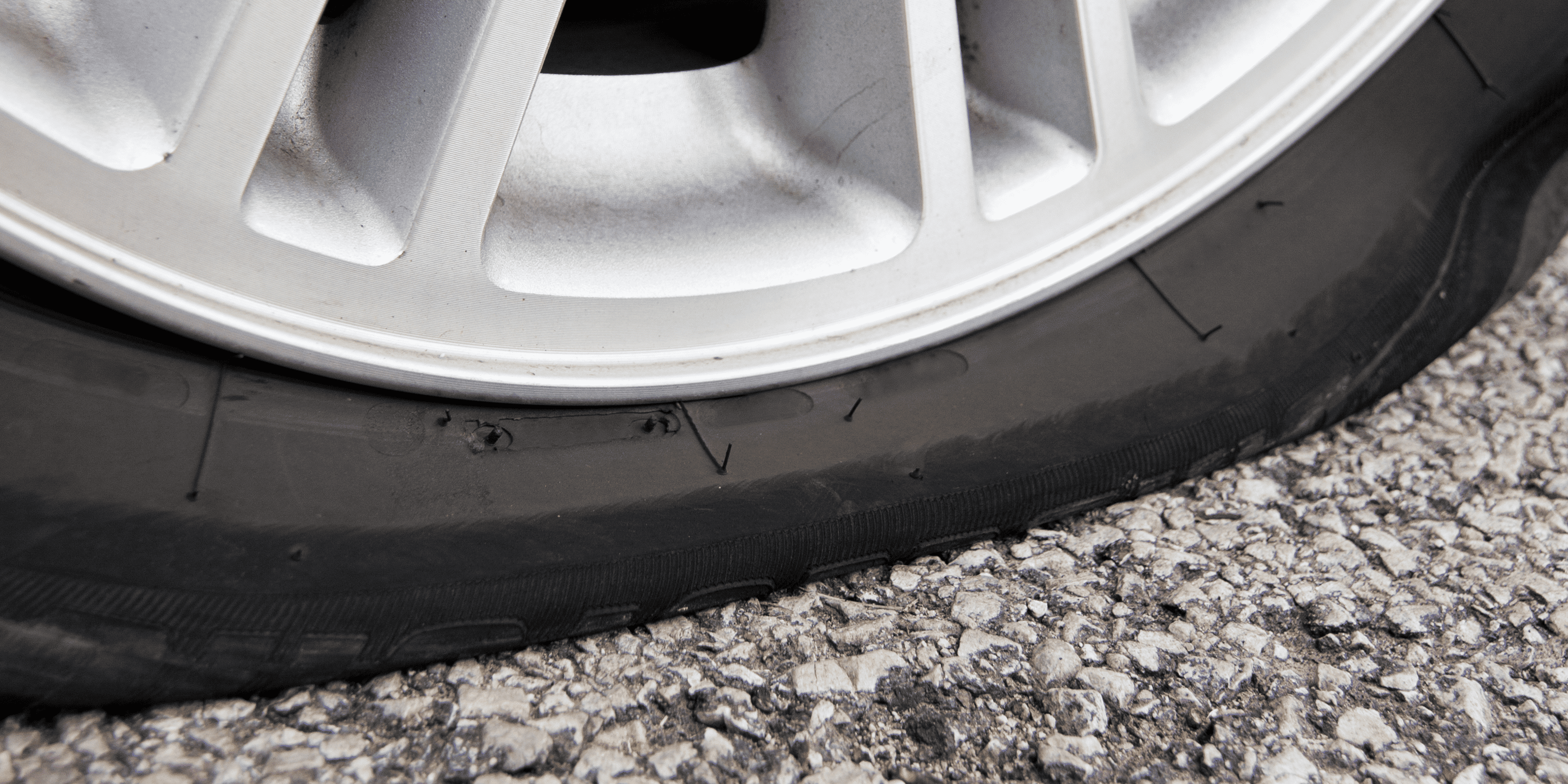
Flat Tire Got You Down? Here’s What To Do
Did you walk out to your car in the morning and spot your tire sagging on the ground? Or maybe were you driving and heard the awful noise of an airless tire?
A flat tire is never fun, but it doesn’t have to ruin your day. Here are some tips on how to prepare for a future flat tire – and what to do if it’s already happened.
WHAT CAUSES A FLAT TIRE?
The most common cause of a flat tire is a penetrating object such as a nail, screw or staple. Sometimes an object penetrates the tire and then falls out, creating a slow leak in the tire.
Other times, tires have “bad leaks”. This means there’s a leak around the edge of the wheel where the tire attaches, often caused by a corroded wheel or debris that prevents the tire from making an airtight seal.
WHAT TO DO WHEN YOUR PARKED CAR HAS A FLAT TIRE
1. Inspect the tire
Run your hands along the back and front of the tire to see if you can spot any foreign objects such as a nail or staple. If you can’t see anything, your tire might just be low on air.
2. Put on your spare tire
If you do find a foreign object, you’ll need to put on your spare tire and bring the damaged tire to a service centre. There is always a chance that the tire is repairable. Just remember that spare tires are meant to be temporary – they can’t go the same distance or at the same speed as regular tires, so getting the tire repaired or replaced quickly is key.
3. Never drive on a flat tire
The reason you should put the spare on right away is because you should never drive on a flat tire. Doing so could damage the tire beyond repair, damage your vehicle or cause you to lose control.
4. Call for help if needed
If you don’t have a spare or can’t manage to put the spare on yourself, call a tow truck company, contact CAA or get in touch with your vehicle’s roadside assistance.
WHAT TO DO WHEN YOU GET A FLAT TIRE WHILE DRIVING
1. Stay calm
Try your best not to panic! It can feel scary to have a flat tire, but just know that everything will be okay as long as you stay safe and calm. How you handle the next few steps is important to ensuring your experience goes as smoothly as possible.
2. Pull over safely
Make sure you slow down, hold your steering wheel tight, put your hazards on and pull over to a safe place – off the highway or away from traffic. Do not drive too far or too fast on a flat tire, otherwise you risk damaging your tire rims… which will cost a lot more to replace than just the tire!
3. Put on your spare tire
Put on your spare tire and bring the damaged tire to a service centre. There is always a chance that the tire is repairable. As mentioned earlier, remember that spare tires are meant to be temporary. They can’t go the same distance or at the same speed as regular tires, so getting the tire repaired or replaced as soon as possible is key for your safety.
4. Call for help
If you don’t have a spare or can’t manage to put the spare on yourself, call for help. Call a tow truck company, contact CAA or get in touch with your vehicle’s roadside assistance. And always stay in your vehicle until help arrives.
PREVENTING (& PREPARING FOR) FLAT TIRES
When it comes to flat tires, it’s usually a matter of when, not if. The good news is there are some steps you can take to help prevent one – and prepare for the inevitable.
By remembering some basic tire maintenance and tips, you can hit the road with a little more peace of mind.
Be prepared for the worst. Always have a spare tire, car jack and lug wrench in your vehicle in case of a flat tire emergency. Buy a vehicle emergency kit and store in in your trunk. It’s also not a bad idea to keep some non-perishable snacks in your car in case you need to wait a while for help to arrive.
Learn how to change a tire. You can never be too prepared! YouTube is a great place to educate yourself on how to change a flat tire if you ever find yourself with one. Here are a few popular tutorials:
- How to Change a Tire: A Step-by-Step Guide
- How to Change a Tire | Change a flat car tire step by step
- How to Change a Tire (plus jacking it up)
Keep your tire pressure in check. Check the pressure in your tires at least once a month and fill them when needed. Keep a tire gauge handy in your car and purchase an air pump or compressor – many options are under $30!
Rotate your tires regularly. Having your tires rotated regularly can help prevent uneven wear patterns and prolong the life of your tires. Check what your vehicle manufacturer recommends, but a standard practice is to rotate them every six months.
Avoid hasty hazards. Sometimes it’s unavoidable, but try to take alternate routes if you know you’ll be near construction zones or rundown roads. Hitting a pothole can cause damage to your tires and other parts of your car.
Watch for tire recalls. It’s a good idea to be aware of any manufacturer recalls related to your vehicle and tires. The Government of Canada website provides instructions to register with your tire manufacturer in order to stay up-to-date on any potential recalls.
Get roadside assistance. It’s always better to be safe than sorry. Does your vehicle have the option for roadside assistance? If so, make sure you are familiar with how it works in case of an emergency. There is also the option to purchase roadside assistance with companies like CAA, which come with some extra benefits as a member.
Service and Repairs You Can Trust
Whether you have a flat tire, your vehicle has broken down or it just needs some routine maintenance, you should always be confident in your automotive service provider. Our Birchwood Service Centres provide service and repair for over 22 of the best automotive brands, so you can trust that you are in good hands!
With 17 dealership locations around Winnipeg and a wide range of automotive services and repairs available, we’re the best and most convenient choice for your vehicle servicing needs. Reach out to one of our helpful customer service representatives to get more life and value from your vehicle.




